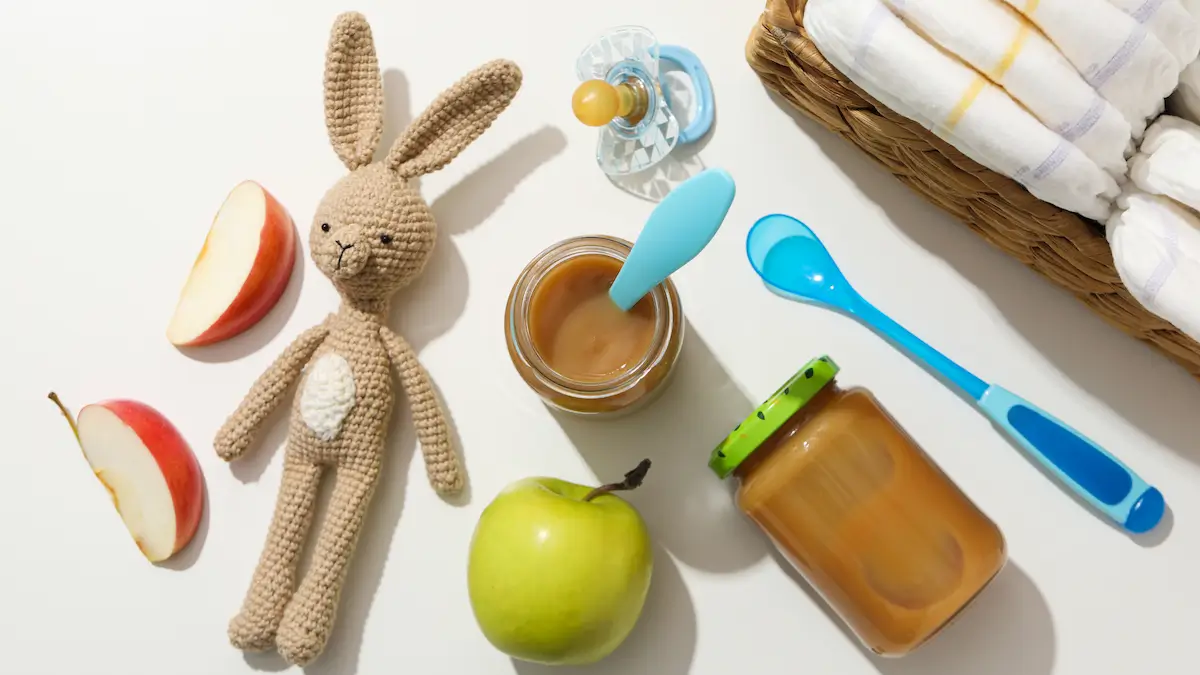
In the first year, babies get most of their nutrition from breast milk or infant formula. Solids start slowly and build over time. Every baby is different, so think of this as a gentle roadmap rather than strict rules. If you’re ever unsure, your GP, child health nurse or a paediatric dietitian can tailor advice for your family.
How Do Babies Get the Nutrients They Need?
- Milk first: Breast milk or iron-fortified infant formula is the primary source of nutrition in the first months.
- When to add solids: Most babies are ready around 6 months (not before 4 months) when they can sit with support, have good head control, show interest in food and have lost the tongue-thrust reflex. Solids complement milk rather than replace it at first.
- Fortification matters: Infant formulas are fortified (including iron). Breast milk composition varies with the mother’s diet.
- Responsive feeding: Watch hunger and fullness cues (rooting, hand-to-mouth, turning away) to guide portion sizes and pace.
The “Big Two” in the First Year — Iron & Vitamin D
Babies need many vitamins and minerals, but iron and vitamin D deserve special attention in the second half of the first year.
Iron (why it matters & how to get it)
By 7–12 months, babies’ iron stores begin to run low, so iron-rich foods are important. Offer:
- Iron-fortified baby cereal
- Minced or puréed red meat, poultry or fish
- Iron-rich plant foods such as lentils, beans and tofu (pair with vitamin C foods like tomato, capsicum, citrus or berries to boost absorption)
Vegetarian or vegan families: speak with a dietitian to plan enough iron and vitamin B12.
Cow’s milk can be used in small amounts in food (e.g., porridge) from ~6 months, but not as a main drink until after 12 months.
Vitamin D (what parents should know)
Vitamin D supports healthy bones and teeth. Sources include safe sun exposure and fortified formula. Breastfed babies with risk factors for low vitamin D (for example limited sun, darker skin, winter births, or maternal deficiency) may be recommended a supplement. Ask your health professional whether this is appropriate for your baby.
Other Key Nutrients to Keep in Mind
Iodine
Important for thyroid function and brain development. Once solids start, offer family foods that naturally contain iodine such as fish, eggs, yoghurt and bread made with iodised salt (no added salt needed for baby portions).
Omega-3 DHA
Supports brain and eye development. Include low-mercury oily fish (e.g., salmon, sardines) in soft, baby-safe forms—flaked into mashed veg or stirred through porridge. If fish isn’t eaten, ask a clinician about alternatives.
Zinc
Helps growth and immune function. Found in meats, legumes, wholegrains and dairy/yoghurt.
Calcium
Supports bones and teeth. Milk feeds supply most calcium early on. Add small amounts of yoghurt/cheese from ~6 months. Don’t give cow’s milk as a drink until after 12 months.
Vitamin B12
Essential for families following vegan diets. Use fortified foods and/or supplements under professional guidance.
Choline
Important for brain development. Good sources include eggs (well-cooked), meats and legumes.
Vitamin C
Helps iron absorption and supports immunity—offer colourful fruit and veg (strawberries, kiwi, citrus, capsicum, tomato).
When & How to Introduce Solids
Timing: Start when baby shows readiness signs around 6 months (not before 4 months). Some clinicians may individualise timing—work with your healthcare professional.
First foods: Begin with iron-rich options (iron-fortified cereal; puréed meats or legumes). Then add vegetables, fruits, grains, and small amounts of yoghurt/cheese, moving towards the family diet.
Textures: Progress stepwise: puréed → mashed → minced/chopped → soft finger foods as skills improve. Keep foods soft and easy to mash with tongue and gums.
Allergens: Introduce common allergens (well-cooked egg, smooth peanut paste, dairy, soy, wheat, fish, sesame) within the first year, when baby is developmentally ready. Once tolerated, keep offering regularly.
Practical Feeding Tips
- Offer small amounts of cooled boiled water in an open or sippy cup with meals from 6 months. Avoid juice and sugary drinks.
- Honey: do not give before 12 months due to the risk of infant botulism.
- Go slow with new foods. Re-offer foods many times; tastes develop with repeated exposure.
- Choking vs gagging: Gagging is common as skills develop. Offer soft, appropriately shaped foods, sit with baby, and avoid hard/round items (whole nuts, raw apple rounds, popcorn).
- Mind the tummy. If your baby seems windy or uncomfortable, these ideas may help: relieve trapped wind.
Sample Day on Solids (Illustrative Only)
6–8 months
- Morning: Milk feed → iron-fortified cereal mixed with breast milk/formula + mashed pear
- Midday: Milk feed → puréed beef or lentils + mashed pumpkin
- Afternoon: Milk feed → mashed avocado on soft toast fingers (thin smear)
- Evening: Milk feed → yoghurt (full-fat) + soft fruit purée
- Sips of cooled boiled water with meals
9–12 months
- Breakfast: Porridge with yoghurt + soft fruit pieces
- Lunch: Flaked salmon mixed through mashed potato/veg; soft steamed veg sticks
- Snack: Hummus on soft pita; fruit
- Dinner: Minced chicken with tomato-based sauce, small pasta shapes; grated cheese
- Milk feeds on demand (breast) or as per formula guidance; cooled boiled water with meals
(Adjust portions to your baby’s appetite and cues.)
When to Seek Extra Support
Speak to your GP, child health nurse or paediatric dietitian if you notice poor weight gain, feeding aversion, ongoing constipation/diarrhoea, suspected allergies/eczema, or if you’re planning a vegan/vegetarian infant diet and want to ensure all nutrients are covered. You can also contact us for product-related questions.
A Gentle Note from Infants’ Friend
If wind and tummy discomfort are making feeds harder, some families use Infants’ Friend Colic & Wind Oral Liquid as part of their routine. It contains ingredients traditionally used in Western herbal medicine to relieve wind, bloating and mild indigestion in babies, and is free from alcohol and sugar.
AUST L 367810. Always read the label and follow the directions for use. If symptoms persist, talk to your health professional.

